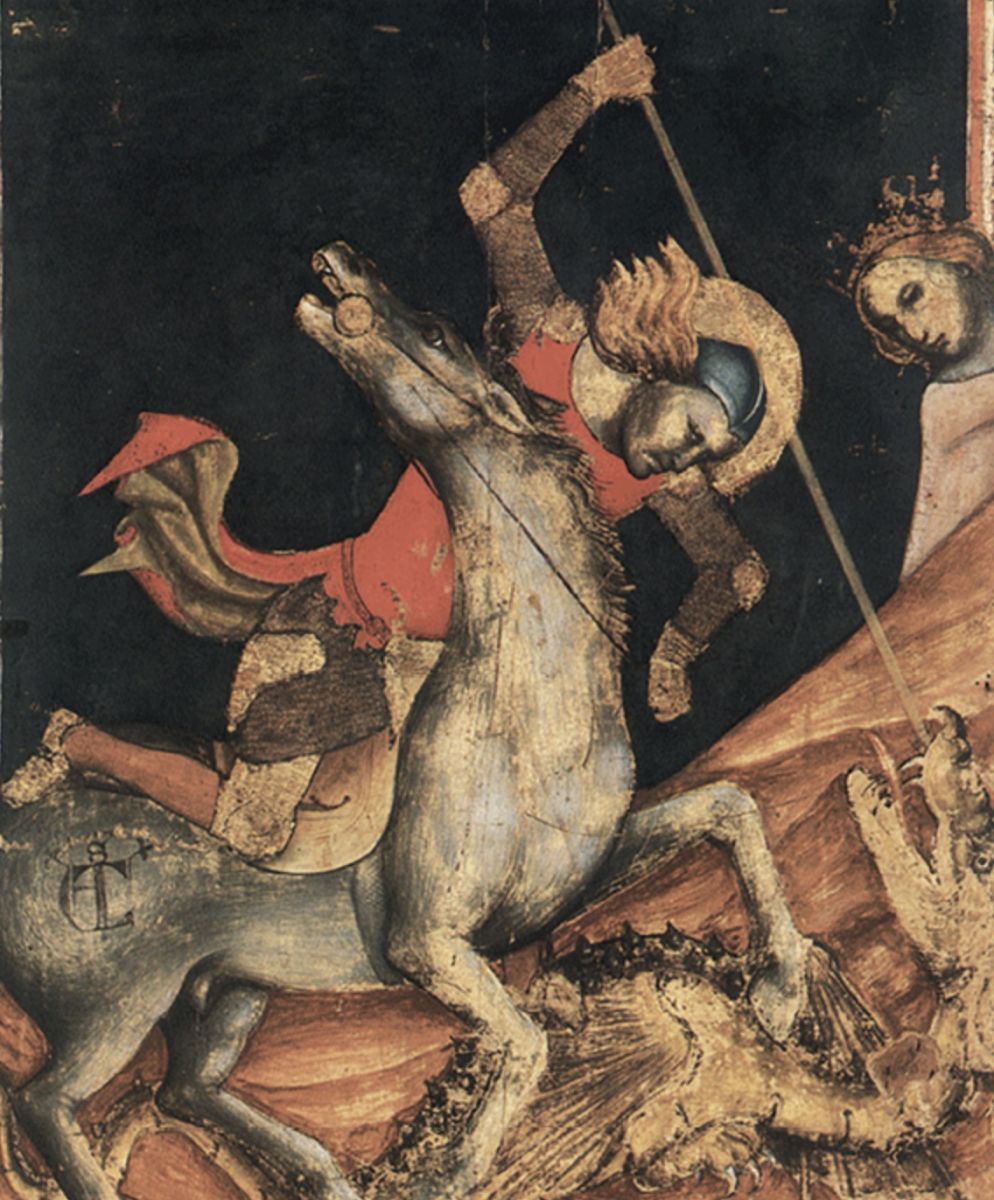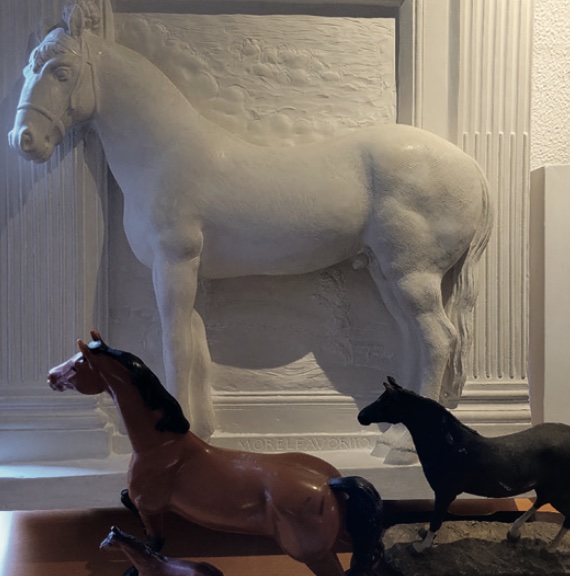Saint George Slaying the Dragon is a masterpiece by Vitale da Bologna, exhibited at the National Art Gallery in Bologna, where a bas relief translation of the autograph work was designed for the blind and visually impaired, inviting tactile exploration. George belongs to the type of legendary saints and according to tradition his death as a martyr dates back to the beginning of the fourth century AD. Portrayed in the act of fighting and slaying a dragon, Saint George represents Miles Christi, intent on opposing that which undermines faith and oppresses the weak. Legend has it that George was a noble knight-errant, originally from Cappadocia, who arrived in the kingdom of Silene, in Cyrenaica, a place plagued by the presence of a terrible dragon, whose destructive power could only be appeased by human sacrifices.  It was the Soldier of Christ who saved the king’s daughter from the jaws of the monster, and as a reward he wanted neither honours nor material gifts, inviting the locals to convert to Christianity and receive baptism. Of Saint George we have little historical information: the only certain fact is his martyrdom, which took place in early fourth century Palestine. Jacopo da Varagine himself, the Dominican friar who, in the 13th century, collected numerous hagiographic tales, recorded in his Legenda Aurea, advised reading the deeds of the knight in a symbolic, not literal key. Saint George, in fact, exemplifies the eternal struggle of good against evil, modelled on the battle waged by the Archangel Michael, as described in the book of Revelation: a text from which, presumably, the image of the dragon is also taken. The concept of Miles Christi, already introduced by St. Paul at the time of the great ecclesiastical reforms and the Crusades, received a new meaning when St. Bernard of Clairvaux referred to the new Christian Knight as a martyr fighting in the service of the faith. What can such a strong and theologically charged theme communicate to children, young people, and adults today? How much can the idea of conflict resonate inwardly; of gratuitousness of gesture, the hypothesis of engaging in a struggle in virtue of an ideal, at the sacrifice of one’s own and others’ lives. If we wanted to go beyond the vulgate, beyond all confessions and comparisons between doctrines, beyond all ideological and political pronouncements, what is imprinted on everyone’s conscience is the image of a heroic act, embodied by one who performs a feat in the name of a principle and knows that he can meet death on his path.
It was the Soldier of Christ who saved the king’s daughter from the jaws of the monster, and as a reward he wanted neither honours nor material gifts, inviting the locals to convert to Christianity and receive baptism. Of Saint George we have little historical information: the only certain fact is his martyrdom, which took place in early fourth century Palestine. Jacopo da Varagine himself, the Dominican friar who, in the 13th century, collected numerous hagiographic tales, recorded in his Legenda Aurea, advised reading the deeds of the knight in a symbolic, not literal key. Saint George, in fact, exemplifies the eternal struggle of good against evil, modelled on the battle waged by the Archangel Michael, as described in the book of Revelation: a text from which, presumably, the image of the dragon is also taken. The concept of Miles Christi, already introduced by St. Paul at the time of the great ecclesiastical reforms and the Crusades, received a new meaning when St. Bernard of Clairvaux referred to the new Christian Knight as a martyr fighting in the service of the faith. What can such a strong and theologically charged theme communicate to children, young people, and adults today? How much can the idea of conflict resonate inwardly; of gratuitousness of gesture, the hypothesis of engaging in a struggle in virtue of an ideal, at the sacrifice of one’s own and others’ lives. If we wanted to go beyond the vulgate, beyond all confessions and comparisons between doctrines, beyond all ideological and political pronouncements, what is imprinted on everyone’s conscience is the image of a heroic act, embodied by one who performs a feat in the name of a principle and knows that he can meet death on his path. .jpg) . Analyzing iconography is an all-encompassing experience, as it requires the didacticism to consider the metaphorical content of a story that also has a history, tradition and literary sources of reference, without trivializing it with easy decontextualization. Vitale, son of Aimo degli Equi (de' Cavalli) documented in Bologna from 1330 to 1359, synthesized figurative experiences of Gothic origin, becoming a fine interpreter and follower of Giotto’s lesson. Vitale degli Equi was so well versed in the art of horsemanship and anatomy that he masterfully rendered both in the set-up of Saint George riding an oriental equine with a grey coat and flowing silver mane. The artist cryptically signs the work with a monogram resembling a brand mark placed on the right hind limb of the horse, thus alluding to his surname of origin. Nature and expression, this was Vitale’s painting, according to art historian Francesco Arcangeli.
. Analyzing iconography is an all-encompassing experience, as it requires the didacticism to consider the metaphorical content of a story that also has a history, tradition and literary sources of reference, without trivializing it with easy decontextualization. Vitale, son of Aimo degli Equi (de' Cavalli) documented in Bologna from 1330 to 1359, synthesized figurative experiences of Gothic origin, becoming a fine interpreter and follower of Giotto’s lesson. Vitale degli Equi was so well versed in the art of horsemanship and anatomy that he masterfully rendered both in the set-up of Saint George riding an oriental equine with a grey coat and flowing silver mane. The artist cryptically signs the work with a monogram resembling a brand mark placed on the right hind limb of the horse, thus alluding to his surname of origin. Nature and expression, this was Vitale’s painting, according to art historian Francesco Arcangeli.

The stance of the rider, raised and off-centre, on the saddle, counteracts the risk of being thrown off his horse, which, frightened, is ready to bolt at the sight of the dragon, while the saint thrusts a lance into its jaws. To internalize a scene of such complexity and vehemence, implies psychologically and pedagogically confronting the concept of contrast, and at the same time performing targeted proprioceptive actions–in support of a haptic exploration of the motor dynamics of horse and rider–preparatory to the appreciation of each refined illustrative detail. For a clear reading of the anatomy of the horse, in teaching with children, we also make use of models of horses in one piece, with movable limbs, and rely on the experience of physical restitution, by modelling clay, of the mental vision of the image: sensorially experienced, cognitively acquired and actually reconstructed. Leading to profound vision also implies practising art conscientiously. Thought and action are inseparable. Every action, guided by intention, moves from thought supported by belief. Going beyond pure visibility is like throwing your heart over the hurdle. This is why the essence of Miles, symbolically understood, still evokes the courage and honour of militancy, the success and nobility of defeat, the human surrender and humility of good deeds.




.png)